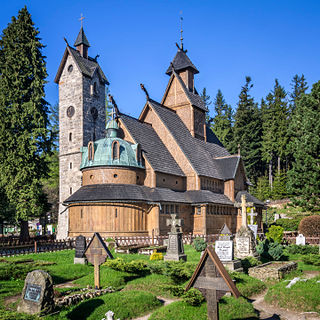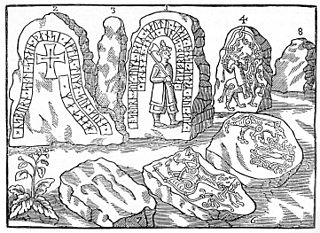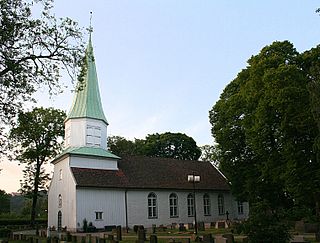

The Oddernes stone (Oddernessteinen) is a rune stone from Oddernes Church at Oddernes in Kristiansand, Vest-Agder, Norway. The stone was originally just in the church yard east of the church. In 1990 it was moved into the church porch. [1] [2]


The Oddernes stone (Oddernessteinen) is a rune stone from Oddernes Church at Oddernes in Kristiansand, Vest-Agder, Norway. The stone was originally just in the church yard east of the church. In 1990 it was moved into the church porch. [1] [2]
Oddernes stone was described in 1639 when the site was visited by Tomas Cortsen Wegner (1588-1654), Bishop of the Diocese of Stavanger. He had been commissioned by Ole Worm to provide inscriptions from rune stones located from within his diocese. Bishop Wegner gave a description of the stone with a drawing of the two inscriptions. Ole Worm was a Danish antiquarian who wrote a number of treatises on rune stones. He was at this time preparing his great work, Monumenta Danica. which was first published during 1643. [3] [4] [5]
Both inscriptions are written with the younger runes and they are approx. dated to year 1030 and to 1040.
The first inscription (N209) is carved on one flat side of the stone, and is almost indistinguishable. It can be read (Old Norse into Latin letters):
....ur- (n)iriþs| |sun is| |st(a)in sa
This is interpreted as "... Neriðs son er steinn sá". In modern English: "After (NN) Neriðs' son is this stone," or "In memory of Tore Neridsson is this stone."
The second inscription on the narrow side of the stone (N210) is much longer and is much more startling:
Worm interpreted parts of this text, namely Olaf hins hala as "Olaf the saint" (St Olaf), and this is reproduced in Monumenta Danica..

In 1805, Danish antiquarian and runologist Martin Friedrich Arendt (1769-1823) documented a number of rune inscriptions and other memorials in southern Norway. At Oddernes he gave a complete reading of the text: Eyvind gerði kirkiu þessa, guðsonr Olafs hin helga, à oðali sinu; modern English: "Eivind made this church, godson of St. Olaf, on his heir". [6] [7]
This interpretation has been accepted by a number of authorities including Sophus Bugge and Magnus Olsen. however others have interpreted the word hala differently, and believe it may have a different meaning than holy or saint. This would override the impression that St. Olaf had actually been present here. As a consequence, the interpretation of this inscription remains debatable. [8]

Åfjord is a municipality in Trøndelag county, Norway. It is part of the Fosen region. The administrative centre of the municipality is the village of Årnes. Other villages in the municipality include Revsnes, Roan, Bessaker, Harsvika, and By. Åfjord is located on the northwestern side of the Fosen peninsula, northwest of the city of Trondheim. It is located between the municipalities of Ørland and Osen and to the west of Steinkjer, with Indre Fosen to the south.

The Rök runestone is one of the most famous runestones, featuring the longest known runic inscription in stone. It can now be seen beside the church in Rök, Ödeshög Municipality, Östergötland, Sweden. It is considered the first piece of written Swedish literature and thus it marks the beginning of the history of Swedish literature.

Lom is a municipality in Innlandet county, Norway. It is located in the traditional district of Gudbrandsdal. The administrative centre of the municipality is the village of Fossbergom. Another village area in Lom is Elvesæter.

Vang Stave Church or Mountain Church of Our Savior is a stave church located in Karpacz in the Karkonosze mountains in Poland. It was transferred to its present location from Vang in the Valdres region of Norway and re-erected in 1842. A notable tourist attraction, it is Poland's only stave church. It serves as a parish church of the Evangelical Church of the Augsburg Confession in Poland.

The Diocese of Stavanger is a diocese in the Church of Norway. It covers all of Rogaland county in western Norway. The cathedral city is Stavanger, where the Stavanger Cathedral is located. The bishop is Anne Lise Ådnøy, who has held the post since 2019.
Scandinavian literature or Nordic literature is the literature in the languages of the Nordic countries of Northern Europe. The Nordic countries include Denmark, Finland, Iceland, Norway, Sweden, and Scandinavia's associated autonomous territories. The majority of these nations and regions use North Germanic languages. Although the majority of Finns speak a Uralic language, Finnish history and literature are clearly interrelated with those of both Sweden and Norway who have shared control of various areas and who have substantial Sami populations/influences.

Tjølling is a former municipality in Vestfold county, Norway. The 70-square-kilometre (27 sq mi) municipality existed from 1838 until its dissolution in 1988. The area is now part of Larvik Municipality. The administrative centre was the village of Tjøllingvollen. Other villages in Tjølling included Hem, Rekkevik, and Ula.
The Ingvar runestones is the name of around 26 Varangian Runestones that were raised in commemoration of those who died in the Swedish Viking expedition to the Caspian Sea of Ingvar the Far-Travelled.

The Hunnestad Monument, listed as DR 282 through 286 in the Rundata catalog, was once located at Hunnestad at Marsvinsholm north-west of Ystad, Sweden. It was the largest and most famous of the Viking Age monuments in Scania, and in Denmark, only comparable to the Jelling stones. The monument was destroyed during the end of the 18th century by Eric Ruuth of Marsvinsholm, probably between 1782 and 1786 when the estate was undergoing sweeping modernization, though the monument survived long enough to be documented and depicted.

Tingvoll Church is a parish church of the Church of Norway in Tingvoll Municipality in Møre og Romsdal county, Norway. It is located in the village of Tingvollvågen. It is the church for the Tingvoll parish which is part of the Indre Nordmøre prosti (deanery) in the Diocese of Møre. The stone church was built in a long church style during the second half of the 1100s by an unknown architect. The church seats about 430 people.
The Italy runestones are three or four Varangian runestones from 11th-century Sweden that tell of warriors who died in Langbarðaland, the Old Norse name for south Italy. On these rune stones it is southern Italy that is referred to (Langobardia), but the Rundata project renders it rather anachronistically as Lombardy.

Trandumskogen is a forest located in Ullensaker, Akershus county, Norway. It was the site of one of the first discoveries in May 1945 of German mass graves in Norway. The German executioner Oskar Hans was the officer in command of the unit performing the executions.

The Varangian Runestones are runestones in Scandinavia that mention voyages to the East or the Eastern route, or to more specific eastern locations such as Garðaríki in Eastern Europe.

The Sigurd stones form a group of eight or nine Swedish runic inscriptions and one picture stone that depict imagery from the Germanic heroic legend of Sigurd the dragon slayer. They were made during the Viking Age and constitute the earliest Norse representations of the matter of the Völsung cycle that is the basis of the Middle High German Nibelungenlied and the Sigurd legends in the Poetic Edda, the Prose Edda, and the Völsunga saga.
The Viking runestones are runestones that mention Scandinavians who participated in Viking expeditions. This article treats the runestone that refer to people who took part in voyages abroad, in western Europe, and stones that mention men who were Viking warriors and/or died while travelling in the West. However, it is likely that all of them do not mention men who took part in pillaging. The inscriptions were all engraved in Old Norse with the Younger Futhark. The runestones are unevenly distributed in Scandinavia: Denmark has 250 runestones, Norway has 50 while Iceland has none. Sweden has as many as between 1,700 and 2,500 depending on definition. The Swedish district of Uppland has the highest concentration with as many as 1,196 inscriptions in stone, whereas Södermanland is second with 391.

The Manx runestones were made by the Norse population on the Isle of Man during the Viking Age, mostly in the 10th century. Despite its small size, the Isle of Man stands out with many Viking Age runestones, in 1983 numbering as many as 26 surviving stones, which can be compared to 33 in all of Norway. So many of them may appear on the Isle of Man because of the merging of the immigrant Norse runestone tradition with the local Celtic tradition of raising high crosses.

Oddernes Church is a parish church of the Church of Norway in Kristiansand Municipality in Agder county, Norway. It is located in the district of Lund in the borough of Lund in the city of Kristiansand. It is one of the churches for the Oddernes parish which is part of the Kristiansand domprosti (arch-deanery) in the Diocese of Agder og Telemark. The white, stone church was built in a long church design around the year 1040 using plans drawn up by unknown architect. This makes it the oldest building in the city of Kristiansand. The church seats about 395 people.

The Grindheim stone is a runestone from Grindheim Church in Etne municipality in Hordaland, Norway.

The Nylarsker stone 2, Ny Larsker stone I or DR 380 is a Viking Age runestone engraved in Old Norse with the Younger Futhark runic alphabet on Bornholm. The runestone was discovered in 1643 and first mentioned in Ole Worm's Monumenta Danica. It was to be found outside the entrance of Nylars Church until 1855. It is securely dated to the period 1075–1125, and belongs to a group of Bornholm runestones that were made during the transition from the Viking Age to the Nordic Middle Ages. It made in sandstone and it is 186 cm tall, 146,5 cm wide and 17 cm thick, and the style of the runestone is the runestone style RAK.